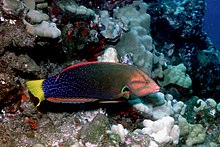Coris gaimard
| Coris gaimard | |
|---|---|

| |
| Female | |
| Scientific classification | |
| Domain: | Eukaryota |
| Kingdom: | Animalia |
| Phylum: | Chordata |
| Class: | Actinopterygii |
| Order: | Labriformes |
| Family: | Labridae |
| Genus: | Coris |
| Species: | C. gaimard
|
| Binomial name | |
| Coris gaimard | |
| Synonyms[2] | |
|
List
| |
Coris gaimard, the yellowtail wrasse or African coris, among other vernacular names, is a species of wrasse native to the tropical waters of the central Indian Ocean and the western Pacific Ocean, from Christmas Islands and Cocos Keeling Islands to the Society Islands, Hawaii, and from Japan to Australia. It is an inhabitant of coral reefs, being found in areas that offer a mix of sand patches, rubble, and coral at depths from 1 to 50 m (3.3 to 164.0 ft). This species can also be found in the aquarium trade and is popular species for display in public aquaria.[2]
This species can reach 40 cm (16 in) in total length, though most do not exceed 20 cm (7.9 in).[2] As a juvenile, it is a bright red colour with large, black-margined white spots. As an adult, it has a pink face and fins, with the exception of the tail fin, which is bright yellow. The body is green towards the anterior darkening and decorated with bright blue specks towards the caudal peduncle. The fish also gains a very bright orange anterior when it grows into adulthood, and has a drastically shaded body in the posterior region that is dotted with very bright blue spots ringed with dark blue.
Gallery
[edit]-
Male (terminal phase)
-
Female
-
Female being cleaned by a Hawaiian cleaner wrasse
-
Female
-
Female
-
Female
-
Juvenile
References
[edit]- ^ Pollard, D.; Liu, M. (2010). "Coris gaimard". IUCN Red List of Threatened Species. 2010: e.T187436A8534848. doi:10.2305/IUCN.UK.2010-4.RLTS.T187436A8534848.en. Retrieved 20 November 2021.
- ^ a b c Froese, Rainer; Pauly, Daniel (eds.). "Coris gaimard". FishBase. August 2013 version.
External links
[edit]- Nicolas Bailly (2013). Bailly N (ed.). "Coris gaimard (Quoy & Gaimard, 1824)". FishBase. World Register of Marine Species. Retrieved October 15, 2013.
- Photos of Coris gaimard on Sealife Collection













